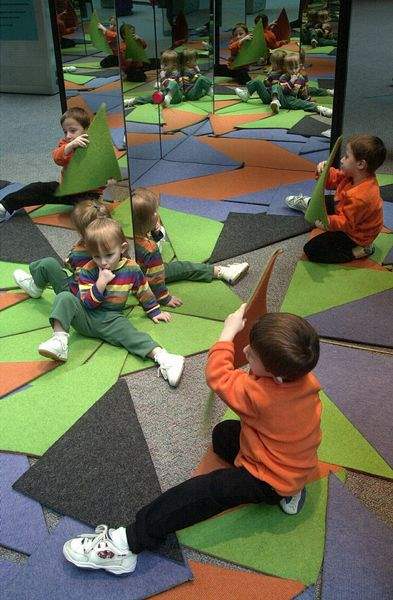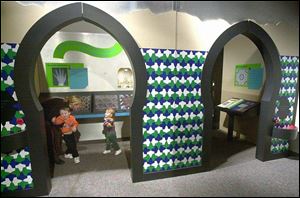
COSI exhibit adds up to math fun
1/19/2001
Jake Roman, 4, and Madeleine Roman, 2, play with geometric shapes in the Hall of Mirrors display at the “Beyond Numbers” exhibition that opens tomorrow at COSI.
Parents, here's a neat little trick you can play on your kids. Suggest that you'll give them an allowance of a penny a week, with a promise to double the amount every week. Most children will scoff at such a paltry-sounding deal, and turn you down flat. Then you can laugh and show them how they blew it, because the size of their allowance would really have grown in time.
Of course, if your child happens to be smart enough to take you up on your offer, he or she will own your house in a matter of months. Sorry about that.
This is just one example of the interesting twists that mathematics can bring to everyday life, which is pretty much the theme of “Beyond Numbers,” the newest traveling exhibit to be featured at COSI Toledo. The exhibit, which opens tomorrow at the downtown riverfront science museum, runs through May 28.
With 33 hands-on displays set up in three separate sections of the museum, “Beyond Numbers” is one of the largest traveling exhibits ever set up at COSI. Developed by the Maryland Science Center and George Washington University, it's not the most high-tech exhibition to grace the halls and galleries of COSI, but there's plenty in it to capture the imagination.
“This is not about the math you learned in school,” said Carl Nelson, the museum's exhibits director. “It will show kids, and adults too, that math ties into nature, and art, and is a part of everything from planetary science to whitewater rafting.”

Baya Toman, of Toledo, plays with her children, Jake and Madeleine in the "Beyond Numbers" exhibit.
Besides plenty of dancing computer animations, clever puzzles, and interactive experiments, several displays will pose simple problems that visitors will be invited to solve - using mathematical principles, of course. Among them: Position 10 fire stations to protect a city, using the least amount of resources; plan a salesman's itinerary to visit a dozen cities and return home covering the shortest distance, and assign tasks to different helpers as you plan a neighborhood block party.
Though the exhibit focuses primarily on the everyday applications of math, there are also a few morsels sure to delight the protractor-in-the-pocket crowd as well. One of these deals with an esoteric string of numerals called Fibonacci numbers. The specific sequence of the numbers not only shows up in many objects in nature, such as flower petals, pineapples, and seashells, but serves as inspiration for artists and architects worldwide.
Another esoteric topic is the Mobius model, which demonstrates that when one end of a two-sided piece of paper is twisted a half turn and glued to the other end, it magically turns out to have only one side. (Sounds confusing, but a COSI staff member can show you how to do it yourself.) This concept found a practical use in factories more than a century ago as designers discovered that it could virtually double the life of belts used in pulley systems.
Despite such examples of mathematical minutiae, Mr. Nelson insists the exhibit is nowhere near as daunting as it might appear to the math-challenged masses. “We're not solving Fermat's Last Theorum here,” he laughed, referring to a famous, centuries-old unsolved problem involving numerical theory. “We're learning a few things, and having some fun.”
At one display, visitors are invited to try turning a shirt worn by a mannequin inside out without removing it. (Hint: Start with the cuffs.). Another invites visitors to decide how many different colored crayons are needed to color countries on a map without ever having two of the same color adjoining. (Hint: It depends whether the map is flat or on a globe.)
There are a few “gee-whiz” displays, such as a computer simulation that shows things like coffee cups morphing into doughnuts. This will probably remind some people of movies such as The Terminator or The Matrix, but it actually relates to a branch of geometry called topology.
A number of events are planned at COSI over the next few months to tie in with the exhibit, including painting, spinning, and building activities, as well as musical appearances by members of the Toledo Symphony and local musician Kerry Clark. During Casino Science Week in April, visitors can learn about the probability and statistics involved in the gaming industry.
COSI, located at Summit and Adams streets in downtown Toledo, is open from 10 a.m. to 5 p.m. Monday through Saturday, and noon to 5 p.m. Sunday. Admission is $7.50 for adults and $6.50 for seniors 65 and over and children age 2 to 18. There is no additional charge for admission to the “Beyond Numbers” exhibit. Information: 244-2674 or www.cosi.org.